Contactless ignition systems with distributor
Examination
Models with an ignition coil built into the distributor
1. Disconnect the negative cable from the battery.
Attention! If the stereo system installed in the car is equipped with a security code, before disconnecting the battery, make sure that you have the correct combination to activate the audio system!
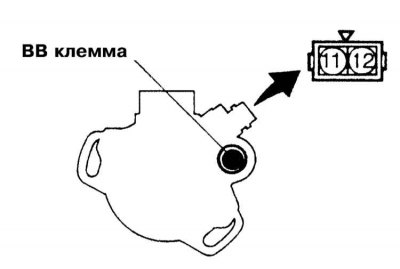
2. Measure the resistive resistance of the primary winding of the ignition coil:
- a) Disunite a contact socket of electroconducting of the distributor of ignition;
- b) Using an ohmmeter, measure the resistance between the two terminals of the connector on the distributor housing (on 3.5 l models, the measurement is made between terminals 1 and 2 of the connector);
- c) Compare measurement result with regulatory requirements (0.9÷1.2 ohm: for 1.5l, 1.8l and 2.4l models and 0.5÷0.7ohm: for 3.5l models);
- d) If the resistance is normal, therefore, there are no breaks and short circuits in the winding;
- e) If the measurement result is out of range, replace the coil.
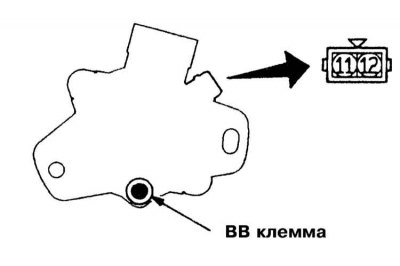 | 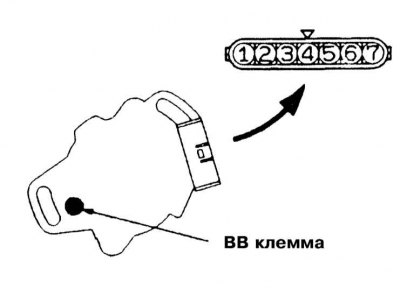 |
3. Next, measure the resistive resistance of the secondary circuit of the coil:
- a) Connect one of the meter wires to the ignition coil secondary winding terminal on top of the distributor cap;
- b) Connect the second wire to terminal 1 or 2 of the distributor connector.
- c) Read the ohmmeter reading and compare the measurement result with regulatory requirements (20÷29 kΩ: for models 1.5 l, 1.8 l and 2.4 l and 9÷13 kΩ: for models 3.5 l);
- d) If the resistance is normal, therefore, there are no breaks and short circuits in the winding;
- e) If the measurement result is out of range, replace the coil.
Models with separately installed ignition coil
1. Disconnect the negative cable from the battery.
Attention! If the stereo system installed in the car is equipped with a security code, before disconnecting the battery, make sure that you have the correct combination to activate the audio system!
2. Measure the resistive resistance of the primary winding of the ignition coil:
- a) Disconnect the ignition coil wiring connector;
- b) Using an ohmmeter, measure the resistance between the two terminals of the connector on the distributor housing;
- c) Compare measurement result with regulatory requirements (0.9÷1.2 ohm: for 2.0L SOHC models and 0.72÷0.88 ohm: for 3.0L SOHC models);
- d) If the resistance is normal, therefore, there are no breaks and short circuits in the winding;
- e) If the measurement result is out of range, replace the coil.
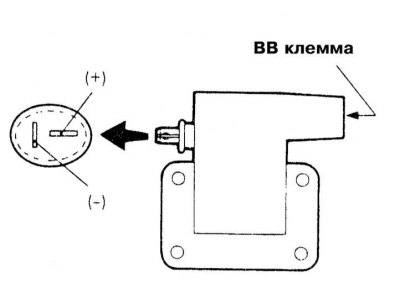
3. Next, measure the resistive resistance of the secondary circuit of the coil:
- a) Connect one of the meter wires to the ignition coil secondary winding terminal on top of the distributor cap;
- b) Connect the second wire to terminal 1 or 2 of the distributor connector.
- c) Read the ohmmeter reading and compare the measurement result with regulatory requirements (20÷29 kΩ: for 2.0 SOHC l and 10.29÷13.92 kΩ models: for 3.0 l SOHC models);
- d) If the resistance is normal, therefore, there are no breaks and short circuits in the winding;
- e) If the measurement result is out of range, replace the coil.
Replacement
Models with an ignition coil built into the distributor
On these models, the coil is built into the ignition distributor assembly (see below).
Models with separately installed ignition coil
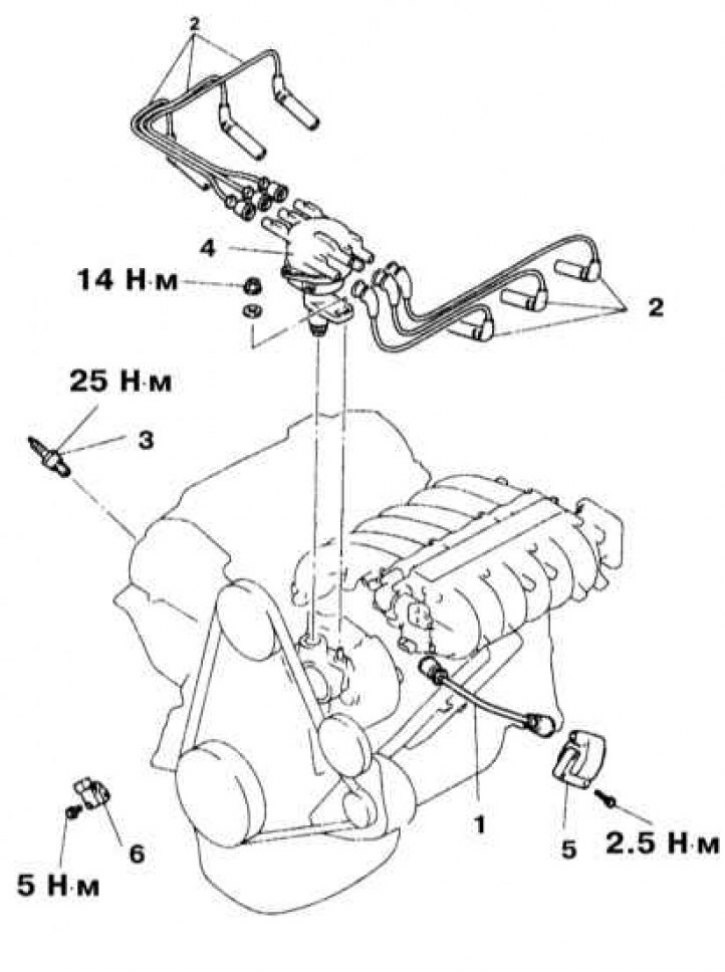
Details of installation and connection of the ignition coil on models 3.0 l SOHC
1 - BB wire; 2 - Candle wires; 3 - spark plug; 4 - Ignition distributor; 5 - Ignition coil; 6 - Key transistor of the ignition system
1. Details of installation and connection of the ignition coil in a contactless system are shown in the illustration.
2. Disconnect the negative cable from the battery.
Attention! If the stereo system installed in the car is equipped with a security code, before disconnecting the battery, make sure that you have the correct combination to activate the audio system!
3. Disconnect the BB wire from the ignition coil (pull on the terminal tip, and in no case on the wire itself!).
4. Disunite a contact socket of electroconducting of the coil.
5. Turn out fixing screws and remove assembly of the coil of ignition from the engine.
6. Installation is carried out in the reverse order.
Direct ignition system (DIS)
Examination
Engines 1.6 l and 2.0 l DOHC 1990 release.
1. Disconnect the negative cable from the battery.
Attention! If the stereo system installed in the car is equipped with a security code, before disconnecting the battery, make sure that you have the correct combination to activate the audio system!
2. Disconnect the coil harness connector.
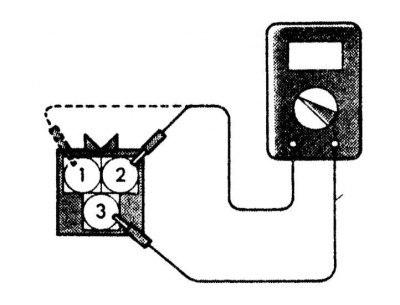
3. Measure the resistive resistance of the primary winding of the ignition coil:
- a) Using an ohmmeter, measure the resistance between terminals 4 and 2 of the connector (for coils on the side of cylinders nos. 1 and 4) /4 and 1 (for coils on cylinder side 2 and 3);
- b) Compare measurement result with regulatory requirements (0.77÷0.95 Ohm).
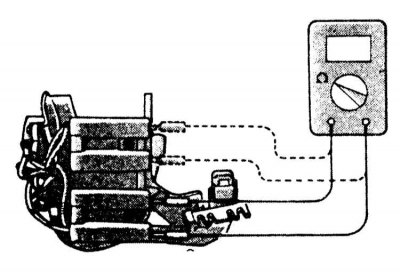
4. Next, measure the resistive resistance of the secondary circuit of the coil:
- a) Disconnect the wiring from the coil;
- b) Measure the resistance between the HV terminals of cylinders Nos. 1 and 4 and Nos. 2 and 3, respectively;
- c) Connect one of the meter wires to the ignition coil secondary winding terminal on top of the distributor cap;
- d) Compare measurement result with regulatory requirements (10.3÷13.9 kOhm);
5. If the result of at least one of the measurements is out of range, replace the corresponding coil.
Engines 2.0 l DOHC 1991÷1993 issue
1. Disconnect the negative cable from the battery.
Attention! If the stereo system installed in the car is equipped with a security code, before disconnecting the battery, make sure that you have the correct combination to activate the audio system!
2. Disconnect the coil harness connector.
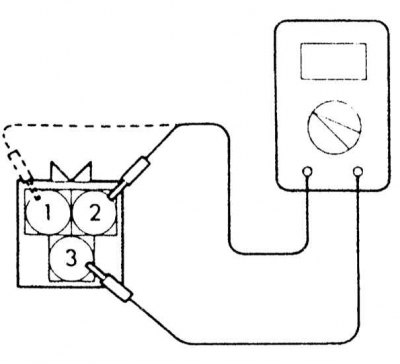
3. Measure the resistive resistance of the primary winding of the ignition coil:
- a) Using an ohmmeter, measure the resistance between terminals 3 and 2 of the connector (for coils on the side of cylinders nos. 1 and 4) /3 and 1 (for coils on cylinder side 2 and 3);
- b) Compare measurement result with regulatory requirements (0.70÷0.86 Ohm).
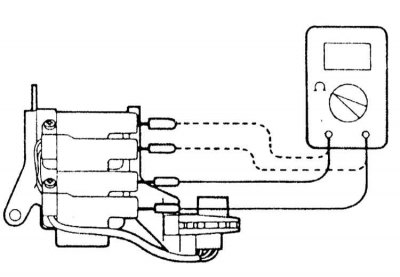
4. Next, measure the resistive resistance of the secondary circuit of the coil:
- a) Disconnect the wiring from the coil;
- b) Measure the resistance between the HV terminals of cylinders Nos. 1 and 4 and Nos. 2 and 3, respectively;
- c) Connect one of the meter wires to the ignition coil secondary winding terminal on top of the distributor cap;
- d) Compare measurement result with regulatory requirements (11.3÷15.3 kOhm).
5. If the result of at least one of the measurements is out of range, replace the corresponding coil.
Engines 1.8 l 1997÷2000 issue and 2.4 L SOHC 1999 and 2000 issue
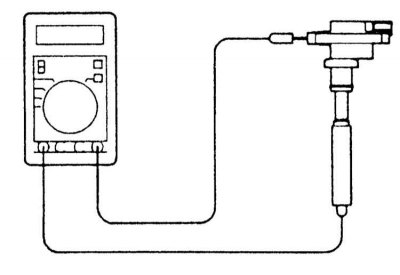
Measure the resistive resistance of the secondary circuit of the coil:
- a) Connect one of the meter wires to the secondary terminal of the ignition coil;
- b) Connect the second wire to terminal 1 or 2 of the coil connector;
- c) Read the ohmmeter reading and compare the measurement result with regulatory requirements (9.4÷12.8 kOhm);
- d) If the resistance is normal, therefore, there are no breaks and short circuits in the winding;
- e) If the measurement result is out of range, replace the coil.
2.4L DOHC engines
1. Disconnect the negative cable from the battery.
Attention! If the stereo system installed in the car is equipped with a security code, before disconnecting the battery, make sure that you have the correct combination to activate the audio system!
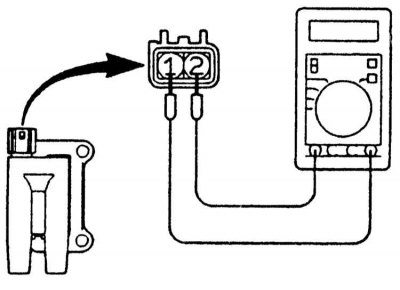
2. Measure the resistive resistance of the primary winding of the ignition coil:
- a) Disconnect the wiring from the coil assembly;
- b) Using an ohmmeter, measure the resistance between the two terminals of the coil connector:
- c) Compare measurement result with regulatory requirements (0.74÷0.90 Ohm).
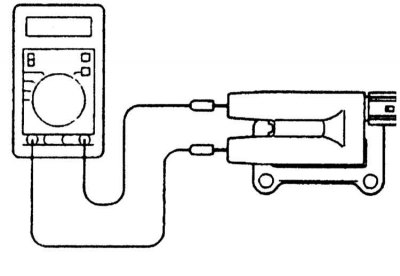
3. Next, measure the resistive resistance of the secondary circuit of the coil:
- a) Mark and disconnect the spark plug wires from the coil assembly;
- b) Measure the resistance of the secondary circuit between the terminals of each of the individual coil modules;
- c) Compare measurement result with regulatory requirements (20.1÷27.3 kOhm);
4. If the result of any of the measurements is out of range, replace the corresponding coil.
2.4L DOHC engines
1. Disconnect the negative cable from the battery.
Attention! If the stereo system installed in the car is equipped with a security code, before disconnecting the battery, make sure that you have the correct combination to activate the audio system!
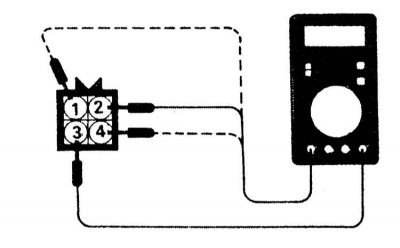
2. Measure the resistive resistance of the primary winding of the ignition coil:
- a) Disconnect the wiring from the coil assembly;
- b) Using an ohmmeter, measure the resistance between the respective terminals of the coil connectors (terminals 2 and 3 - for module A; terminals 1 and 3 for module B and terminals 4 and 3 for module C);
- c) Compare measurement result with regulatory requirements (0.67÷0.81 Ohm).
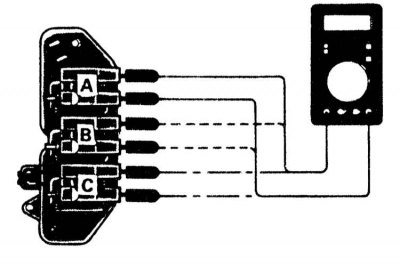
3. Next, measure the resistive resistance of the secondary circuit of the coil:
- a) Using an ohmmeter, measure the resistance between the respective terminals of the coil connectors (terminals 1 and 4 - for module A; terminals 2 and 5 for module B and terminals 3 and 6 for module C);
- b) Compare measurement result with regulatory requirements (11.3÷15.3 kOhm).
4. If the result of any of the measurements is out of range, replace the corresponding coil assembly
Replacement
1.6L, 2.0L DOHC and 2.4L DOHC engines
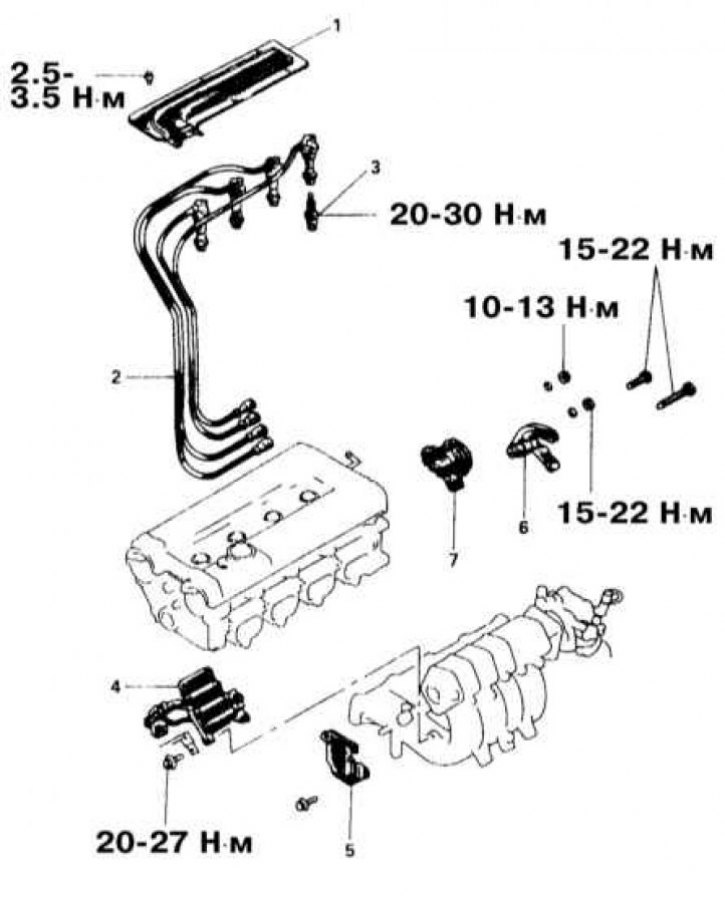
Details of installation and connection of the ignition coil on models 1.6 l and 2.0 l DOHC
1 - Central cover; 2 - Candle wires; 3 - spark plug; 4 - Ignition coil; 5 - Key transistor of the ignition system; 6 - Throttle body mounting bracket; 7 - CKP sensor
1. Installation details of the ignition system components on models equipped with 1.6L, 2.0L DOHC and 2.4 DOHC engines are shown in the illustration.
2. Disconnect the negative cable from the battery.
Attention! If the stereo system installed in the car is equipped with a security code, before disconnecting the battery, make sure that you have the correct combination to activate the audio system!
3. Mark and disconnect the spark plug wires from the coil assembly - pull only by the tip, and in no case by the wire itself!
4. Disconnect other electrical wiring from the coil.
5. Turn out fixing screws and remove coil assembly from the engine.
6. Installation is carried out in the reverse order.
Engines 1.8 l 1997÷2000 issue and 2.4 l since 1999 vol.
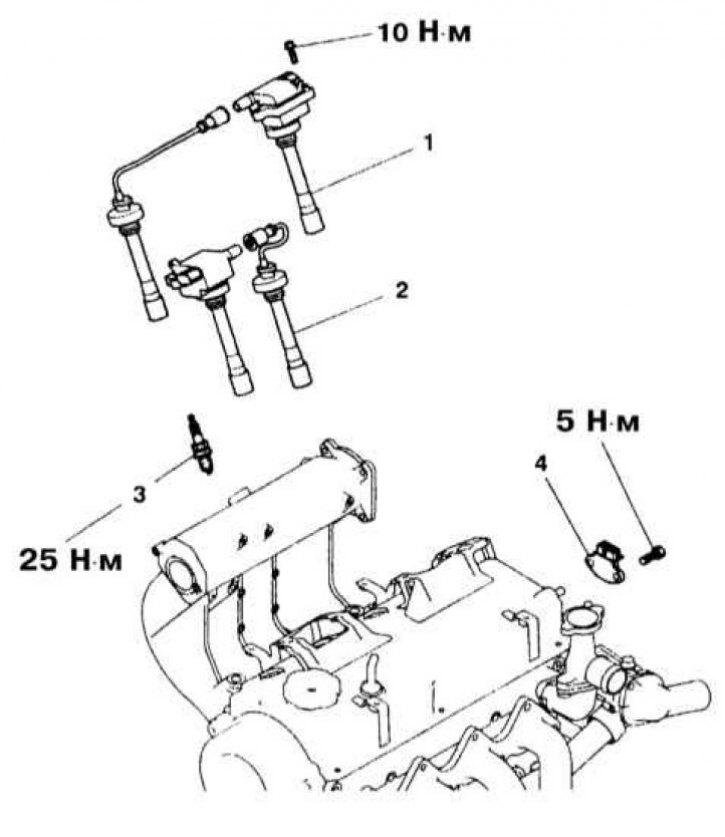
Details of installation and connection of the ignition coil on models 1.8 l since 1997 vol. and 2.0 L DOHC since 1999
1 - Ignition coil; 2 - Candle wires; 3 - spark plug; 4 - Ignition failure sensor
1. Installation details of the ignition system components on models equipped with 1.8 liter engines from 1997 vol. and 2.4 L DOHC since 1999 vol. shown in the illustration.
2. Disconnect the negative cable from the battery.
Attention! If the stereo system installed in the car is equipped with a security code, before disconnecting the battery, make sure that you have the correct combination to activate the audio system!
3. Disconnect from coil (ek) wiring.
4. Remove the spark plug wires of the respective cylinders.
5. Turn out fixing bolts and remove the corresponding coil from a head of cylinders.
6. Installation is carried out in the reverse order.
3.0L DOHC engines
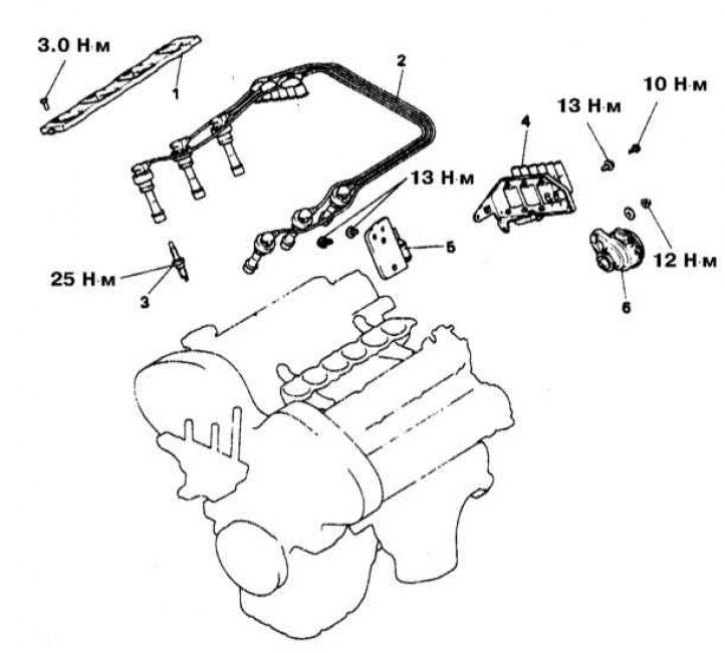
Details of installation and connection of the ignition coil on models 3.0 l DOHC
1 - Central cover; 2 - Candle wires; 3 - spark plug; 4 - Ignition coil; 5 - Key transistor; 6 - CKP sensor (with built-in CMP sensor) (model 1992 vol.)
1. Details of installation of components of the ignition system on models equipped with 3.0L DOHC engines are shown in the illustration.
2. Disconnect the negative cable from the battery.
Attention! If the stereo system installed in the car is equipped with a security code, before disconnecting the battery, make sure that you have the correct combination to activate the audio system!
3. Remove the pressure chamber from the inlet pipeline (upper section of pipeline) (see chapter Engine).
4. Mark and disconnect the spark plug wires from the coil assembly - pull only by the tip, and in no case by the wire itself!
5. Disconnect other electrical wiring from the coil.
6. Turn out fixing screws and remove spool assembly from the engine.
7. Installation is carried out in the reverse order.
